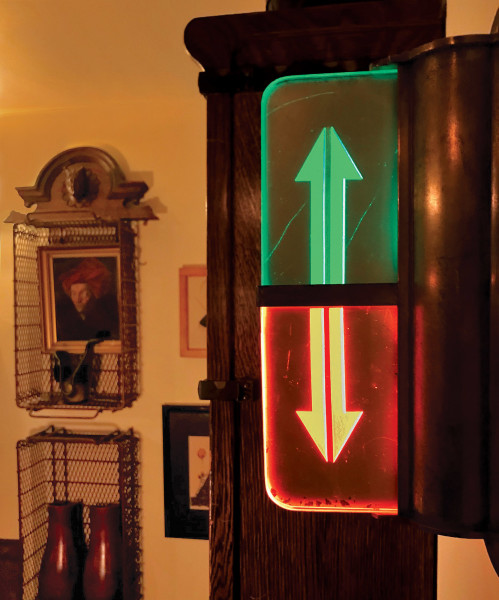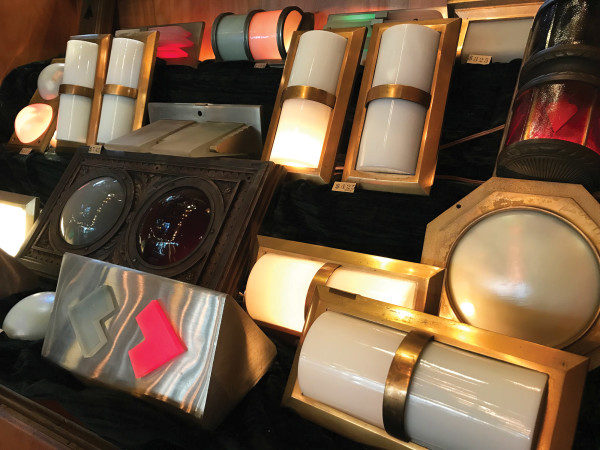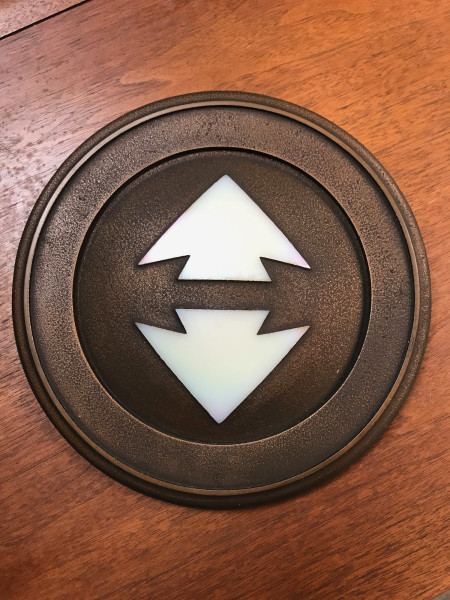Bret Hodgert, who owns Old Portland Hardware in Oregon, has always been fascinated by elevators. He explains that historic floor-indicator lights were often works of art in brass or bronze and glass. Most of them disappeared as buildings were renovated and elevators updated. Whenever he finds an old indicator light for sale, Bret buys it to add to his collection. He’s repurposed them as vanity mirror sconces and home-theater lights—he even mounted one outside a bathroom to show when the room is occupied! He also installed a pair of Art Deco-style indicator lights in his own den, replacing the wall sconces.
A repurposed elevator indicator light.
The DIY Process
1. A cleanup
Hodgert prefers to save the original finish whenever possible. Any dirt and misapplied paint layers may be removed by soaking the piece overnight in hot, soapy water, then scraping it with a stiff nylon brush. He uses a pair of bamboo chopsticks, sharpened into points, as chisels for hard-to-reach corners and crevices. A fine, brass-bristle brush and a dental pick also may be used to remove remaining paint from the metal.
Whenever Bret Hodgert finds an old indicator light for sale, Bret buys it to add to his collection.
2. Wiring
In most cases, a simple brass backplate is fashioned and the light itself is professionally rewired. To wire the sconce into existing junction boxes on the wall, Hodgert shuts off the power at the circuit breaker, then removes the old wall sconces and disconnects the wires (first the black hot wire, then the white neutral wire, finally the copper ground wire). The green ground screw is unscrewed and removed from the bracket, which is then lifted off the junction box. The mounting bracket is reused for the indicator-light sconce and screwed into the top and bottom of the junction box. The ground wire is then reattached to the green ground screw on the bracket, and the bare house wire attached to the bare fixture wire with a wire nut. The white wire is then attached to the one on the sconce with a wire nut, secured with electrical tape, and the black wire attached in a similar fashion. Make sure the wire nuts are properly sized for the gauge of the wire to avoid slippage. After tightening, gently pulling on the wires will ensure both are properly engaged.
3. Mounting on the wall
Once tightened, the wires are carefully pushed back inside the junction box through the opening in the mounting bracket, coiled like a spring to avoid kinking. The light is then attached to the mounting bracket with screws and mounting nuts. Once the power is on, the sconce is ready to dazzle.
Different types and styles of elevator indicator lights are ready for use as wall sconces. Brass, bronze, and art glass are timeless.
Elevators, a Brief History
While vertical lifts have been around for centuries, historical types were unreliable due to weak and fraying ropes. It wasn’t until 1853 that elevators became commonplace, after Elisha Otis patented a safety device and braking designs. His systems allowed elevators to safely transport passengers more than a storey or two, paving the way for modern skyscrapers and modern urban centers.







